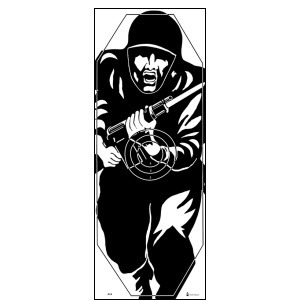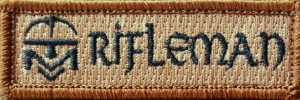MVT Rifleman Challenge: The Shooting Standard
I had maybe two or three commenters express their concern over the shooting standards laid down for the MVT Rifleman Challenge – and there therefore may be others who are also silently concerned. I aim to address that in this post.
The shooting standard of the MVT Rifleman Challenge is as follows:
2. Combat Shooting Qualification: The shoot takes place with a short break after the 2-Miler. Time will be given to walk from the end of the course to the range, drop ruck, drink water and put on LBE. This is designed to simulate combat and the stress of engaging the enemy after the 2-Mile approach.
Pass marksmanship standards on rifle and handgun.Course of Fire:
5 x 10 round magazines rifle, 1 x 10 round magazine handgun.
Short run onto the 50 yard firing point:
10 rounds kneeling
10 rounds prone
40 seconds including magazine changes.
Advance to 25 yards on command:
10 rounds standing
10 rounds kneeling
40 seconds including magazine changes.
Advance on command:
Ready up standing controlled pairs x 5 on command from 25 to 10 yards.
10 yards: transition to handgun, 10 rounds 15 seconds.
Total rounds 60 (rifle 50, handgun 10), To be beta tested further and adjusted if necessary.
Below: Example Ivan Qualification Target:
There are some of important points to note:
1) The standard for a hit is not the whole target, it is the scoring circle in the center of the target. The exact scoring zone we will use is still in beta testing. The standard will be attainable without being unreasonably hard – particularly as this will take place shortly after the 2-Miler, to simulate a move to contact followed by a combat engagement.
2) The range at which this shoot is shot (maximum 50, down to 10 meters) is partially informed by the size of the square range at the MVT facility in West Virginia.
3) However, the scoring area is adjusted for these ranges to give a suitable standard. Also, although this could be shot at longer ranges, it is designed to simulate a combat engagement moving towards the enemy and finally transitioning to handgun.
4) As a point of observation, the use of reduced size silhouette targets to simulate longer ranges at 25 yards is well known.
Am I saying that to be a rifleman you only need to shoot out to 50 meters? Of course not, but we have designed the standard for the West Virginia facility around the facilities that we have. If I was to run this standard out west, it may be shot at longer ranges and the scoring zone adjusted accordingly – however, even then, it would not be a ‘bench shoot’ and would be designed to simulate a combat engagement.
I think that what some are missing is that this is the ‘Rifleman Challenge’ and that a ‘Rifleman’ is so much more than simply a shooter. The standards as laid down are designed to produce an infantryman (Rifleman) as the result of a holistic approach to what this entails. Perhaps some are confused with the Appleseed definition of ‘Rifleman?’ It would also be easy to lose sight of the fact that however well you may be able to shoot, you will fail the Challenge if you cannot complete the other tasks to standard.
And if you are so blown from the 2-Miler that you can’t shoot….
The MVT Rifleman Challenge is about training to standard as a whole Rifleman. It is not a master sharpshooter award. Should you be able to shoot out to 600 meters? Definitely. But just like sniper training, there is the shooting and then there is the rest. You can do a whole class in sniper fieldcraft and stalking without shooting, and you can go away and train the long range shooting somewhere else.
So I think what needs to be done is un-entwine the misconception that a ‘Rifleman’ is simply a master sharpshooter or similar. A ‘Rifleman’ in fact is an infantryman with a number of skills trained to standard. A ‘Rifleman’ may not even be your designated marksman. He needs to be able to effectively engage the enemy in combat, which requires a number of skills from physical fitness through small unit tactics.
Am I saying that great shooting skills are unnecessary? Of course not. Skills above and beyond the Rifleman standard can be trained for and are encouraged. The Rifleman Standard is a basic level.
Am I saying that all engagements will take place under 50 meters? Of course not: and remember that the 50 meter range is compensated for by a smaller scoring zone. Most combat engagements are at 100 meters or less, but that does not negate the need for longer shots, particularly in open country. It would be madness to just train to shoot out to 100 meters and no more.
It is my hope that the MVT Rifleman Challenge standards will spread. Why? Because the aim is to increase standards across the civilian shooting community. I hope that other trainers will take it up. Clearly, depending on the facility at which the Challenge is run there may need to be adjustments. Maybe your range is more suited to a shoot starting at 300 and bringing it down to 25? Maybe that is because you are conducting the test on an open flat area, but at the same time the 2-Miler pass standards would need to be adjusted because there are less hills than in West Virginia.
For example, at the MVT Rifleman Challenge, we will be handing out MVT Rifleman patches to successful attendees. Other schools could hand out their own patches, with ‘ABC Rifleman’ which would show that the standard (or very similar) had been attained, and where it was attained.
One final thing: there have been some misconceptions from people about their ability to pass the Challenge, and what you need to know beforehand. I have explained that in greater detail at the amended MVT Rifleman Challenge page. You don’t need to be fully ‘plug and play’ when you show up, because there will be periods of instruction. We do know that you may not be able to train all the tasks beforehand. You do however need to have your PT, shooting and basic knowledge squared away.
Thank you.
Max


